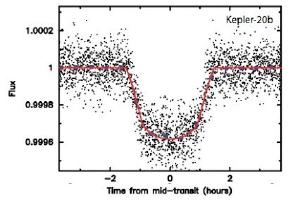Post
Mass Transit
30 August 2012
Last time I talked about binary stars, and how you can observe the orbits of some stars directly to determine their mass. This time we will up our game and look for planets orbiting other stars.
As you might suspect, detecting planets is much more difficult than detecting binary stars. For one, planets are smaller than stars, so their gravitational effects are smaller. For another, they don’t shine like stars, so they tend to be hidden in the glare of their sun.
There are several ways to detect planets, but one of the more interesting methods is known as the transit method. You might remember the recent transit of Venus, when Venus passed in front of the Sun as seen from Earth. Imagine the same thing happening around a star, where a planet transits that star from our point of view.

Credit: NASA/Kepler
When a star’s planet passes between us and the star, some of the starlight is blocked by the planet, making it slightly dimmer. The change isn’t much, only a small fraction of a percent, but it is enough to measure. The figure here shows a plot for a planet known as Kepler 20b, and you can see the effect of the transit is pretty clear.
What is particularly impressive is just how much data we can gather from watching transits such as this one. By measuring multiple transits we can determine the shape and size of its orbit, which tells us the planet’s mass (as well as the mass of the star). By observing how much the star dims during transit, we have a measure of the planet’s size. With size and mass we can determine its density, which tells us something about the type of planet it is (gas giant, rocky, etc.). Knowing its distance from the star gives us a handle on its surface temperature.
Most of the planets we’ve discovered so far by the transit method have been large planets close to their star. As we gather more data it will be easier to detect smaller planets with more Earth-like sizes and orbits. Already we’ve detected planets that lie within their star’s habitable zone. Soon we’ll likely discover an Earth size planet in an orbit similar to ours. All from light curves like the figure above.